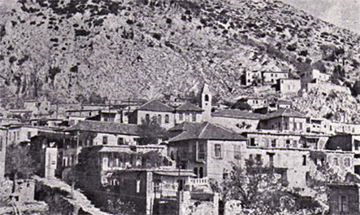Fire and Sword at Kessab
Fire and Sword at Kessab –
Thrilling stories of Armenian massacres –
On Friday 30th July 1909, The Evening News Sydney published an article titled “Fire and Sword at Kessab – Thrilling stories of Armenian massacres”
Mr. H. Martyn Gooch, the secretary of Evangelical Alliance has just received a long letter from the Rev. Stephen Van R. Trowbridge, containing some terrible revelations concerning the sack of Kessab, and the massacre of numbers of its inhabitants by armed Turks and Arabs (says the London “Daily Graphic” of June 19). The story is thrilling in its record of the bravery and endurance of men, women, and children, and throws, as may be expected, a sinister light on the action of ceratin officials and the savagery of the Moslums.
Kessab, says Mr. Trowbridge, was a thrifty Armenian town of about 8000 inhabitants, situated on the landward slope of Mount Cassius (Arabic, Jebel Akra), which stands out prominently upon the Meditteranean Sea Coast, half-way between Alexandretta and Latakia. It is now a mass blackened ruins. What must it mean to the 5000 men and women and little children who have survived a painful flight to the sea coast, and have now returned to their mountain home, only to find their houses sacked and burned! There were nine Christian villages which clustered about Kessab in the valleys below. Several of these have been completely destroyed by fire. All have been plundered, and the helpless people driven out or slain.
On Thursday evening, April 22, the Kessab scouts brought word into the town that great crowds of armed Turks and Arabs had gathered in the nearest Moslem village. It was an anxious night. Before daylight, Friday morning, rifle shots told of the evening’s advance. By three separate mountain trails, from the north, north-east, and east thousands upon thousands of armed Moslems came pouring up the valley. Their Martini rifles sent the bullets whisking into Kessab houses, while the shotguns of the 300 Christians, who were posted on the defence, could not cover the long range. It was a desperately unfair struggle, and the Kessab men realised their straits.
FLIGHT TO THE CLIFFS
The women and girls gathered up the little children on their backs and in their arms, headed along the west trail over the ridge towards Kaladouran, and clambered up into the cliffs and crevices which overlook the sun at an altitude of 5000 feet. Some in small groups, others entirely alone, hid themselves under the thorny underbrush or in the natural caves.
Towards evening the men had been compelled by the overwhelming odds to give up the defence. They fell back without any panic or noise. And the Turks and Arabs who rushed into the streets were so seized with the lust of plunder that they did not pursue the rearguard of the Christians.
One of the saddest experiences was that of Azniv Khanum, wife of the preacher in Kaladouran. Ten days before the massacre she had given birth to twin children, a little boy and girl. When the flight to the mountains took place, she had not the strength to climb with the others, so her husband hid her and their four children among the rocks near the edge of the village. The babies were wrapped in a little quilt, and the other children clung to their mother, while the father hid in a cave close by. Before long, Azniv Khanum and the children were discovered by the Turks. One of the plunderers snatched up the quilt, despite the mother’s entreaties. The two babies rolled out, one in one direction and one in another, over the rough stones.
Then the Turks rudely laid hold of the mother, and, holding a revolver against a breast, ordered her to become a Moslem. She bravely refused. “Then you are my slave,” he said and beat her with the flat of his sword. He commenced to drag her down in order to tie her on his horse. Her foot tripped, she fell, and rolled over and over for about eight yards. There she lay on the rocks, bruised and exhausted, in the hot sun. The Turk, seeing a chance to plunder, abandoned her. Afterwards other Turks took her money and her dress and shoes, and her little girl, about 4 years old. It is wonderful that she lived through it all. One of the little babies lived a week, the other about 10 days after that. When I was in Kaladouran we buried the little boy. It was a very touching service out under the trees.
All the tradesmen’s shops and merchants’ storehouses in Kessab are burned. In fact, the whole market is in ashes. The Roman Catholic and Protestant churches are completely burned. The latter was a spacious building seating a congregation of 1800. The American mission residence, occupied by Miss E. M. Chambers, was burned; so also the Girls’ High School, the Boys’ Grammar School, and the Protestant parsonage.
Unfortunately our space is too circumscribed to give the whole of this graphic letter. But it must be stated that the Evangelical Alliance, as in the past is forwarding financial assistance to the surviving Armenians, who have in many cases lost everything.
The Evening News
The Evening News was the first evening newspaper published in Sydney, Australia. It was published from 29 July 1867 to 21 March 1931.

